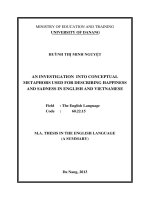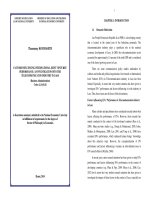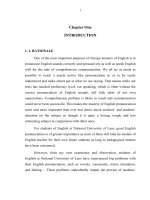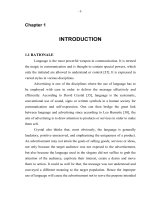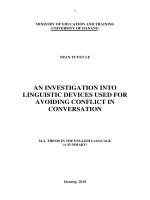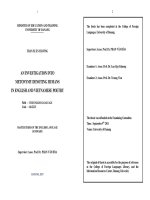An investigation into modality markers used in political speeches by US presidents
Bạn đang xem bản rút gọn của tài liệu. Xem và tải ngay bản đầy đủ của tài liệu tại đây (84.76 KB, 13 trang )
1
MINISTRY OF EDUCATION AND TRAINING
DANANG UNIVERSITY
PHẠM KHẮC THU
AN INVESTIGATION INTO
MODALITY MARKERS USED IN
POLITICAL SPEECHES
BY US PRESIDENTS
Subject area: The English Language
Code: 60.22.15
2
The study has been completed at the College of Foreign Languages,
Danang University
Supervisor: Ngu Thien Hung, Ph.D.
Examiner 1: ……………………………………..
Examiner 2: …………………………………….
The thesis will be orally defensed to the dissertation board
Time :
Venue : Danang University
M.A. THESIS IN THE ENGLISH LANGUAGE
(SUMMARY)
Danang- 2010
The origin of the thesis is accessible for purpose of reference at:
- The College of Foreign Language Library, Danang University
- Danang University Information Resources Centre
3
Chapter 1
INTRODUCTION
1.1. RATIONALE
For the maximal benefit of the second language learners in the
4
- to examine the pragmatic characteristics of modal expressions
in political speeches by US presidents;
- to offer some suggestions for teaching and studying of English
concerning modality markers used political speeches.
context of cross - cultural communication, more attention should be
1.3. THE SIGNIFICANCE OF THE STUDY
paid to ways of expressing their knowledge, judgment and attitude
1.4. RESEARCH QUESTIONS:
towards the content of their speeches. In this sense the second language
1) What types of modality markers are used in political speeches by US
learners can be equipped with insights into and deeper and subtler
presidents?
understanding of the meaningful patterning of organizing thought,
2) What are the linguistic features of the modality markers used in
ideas, judgement in the source language and target language.
political speeches?
When reading or listening to a political speech, the Vietnamese
3) What values of engagement strategies can be described from the
students may not pay sufficient attention to the modal expressions used
analysis of the modality markers used in the political speeches of the
to signal the interpersonal meaning associated with the content of the
US presidents?
message. More often than not, they just focus on the ideational meaning
1.5. SCOPE OF THE STUDY
rather than the subjective meaning transmitted by the speaker.
For these reasons, I would like to choose “An investigation into
This study investigated a wide range of modal expressions used in
all the inaugural speeches of the US presidents. The study dealt with the
Modality markers used in political speeches by US Presidents” as my
grammatical and lexical means of modal expressions.
study with the hope of attempting to consider problematic aspects of
1.6. ORGANIZATION OF THE STUDY
modal meaning with respect to the distinctive features of political
Chapter 1: Introduction
speeches in terms of a discourse analysis.
Chapter 2: Literature review and theoretical background
1.2. AIMS AND OBJECTIVES OF THE STUDY
Chapter 3: Methodology of Study
1.2.1. Aims
This study aims to investigate the linguistic features of modality
markers in political speeches by US presidents, and provide learners of
English practical knowledge in using these modal devices effectively.
1.2.2Objectives
- to examine semantic characteristics of modal expressions in
political speeches by US presidents;
Chapter 4: Linguistic Features of Modality Markers in Political
Speeches
Chapter 5: Conclusion and implications
5
6
Chapter 2
with the help of the other. In logic as well as linguistics several types of
LITERATURE REVIEW
modality are distinguished. In the linguistic literature epistemic modality
AND THEORETICAL BACKGROUND
is contrasted with deontic (root) modality. Epistemic modals take scope
2.1. LITERATURE REVIEW
over whole proposition while root modals modify the predicate of the
Much of the literature in modality (Coates 1983, Perking 1983,
sentence. From the point of view in syntax the two modality is based on
Lyon 1977, Palmer 1986, Chafe and Nichols 1986) often assumes that
the speaker’s knowledge, deontic modality, on the other hand, on
the sole function of modals is to reveal the speaker’s/ writer’s state of
physiscal or mental states or outer circumstances. Formally epistemic
mind or knowledge, to indicate that the speaker/ writer is uncertain or
necessity can be construed as logical entailment and epistemic possibility
tentative and is not committed to the truth value of the propositions.
as logical compatibility.
Lyons (1977) points out two kinds of modality: ‘epistemic’ and
The term of modality, as defined by Như Ý et al [39] is “a
‘deontic’. In his view, epistemic modality is related to issues in terms
lexicogrammatical category featuring the speaker’s relationship with
of knowledge, belief or opinion rather than fact while deontic modality
their utterance and the relationship between proposition and objective
refers to matters in terms of “the necessity or possibility of acts
reality. Modality is one of language universals and falls into essential
performed by morally responsible agents”
categories of natural languages. The propositions of utterances can be
In his contrastive study “Lexical and Grammatical Modality
considered as factual or non - factual desirable or undesirable, possible
Devices Expressing Epistemic Modality in English and Vietnamese”,
or impossible, certain or contingent etc. Modality can be realized by
Ngũ Thiện Hùng (2004) dealt with the linguistic features of a wide
grammatical or lexical devices”.
range of lexical and grammatical devices to signal epistemic modal
According to Palmer [26, p.16] Modality in language, then,
meaning in these two languages in the perspective of relevance theory
concerned with subjective characteristics of an utterance, and it could
by Sperber and Wilson.
even be further argued that subjectivity is an essential criterion for
In a discourse of analysis of political speeches, Ngo thi Thanh
Mai (2007) studied some discourse features of political speeches in
modality.
Modality could, that is to say, be defined as the
grammaticalisation of speakers’ (subjective) attitudes and opinions.
English and Vietnamese. The master candidate pointed put the
The study combining modality and speech - acts can be found
similarities and differences of some discourse features of political
in Palmer [26, p.14]. He states that the distinction between proposition
speeches in English and Vietnamese.
and modality is very close to that of locutionary act and illocutionary
2.2. THEORETICAL BACKGROUND
act as proposed by Austin. In the locutionary act we are” saying some
2.2.1. Modality and Related Terms
thing”- answering a question, announcing a verdict, giving a warning or
Traditionally, modality is defined in terms of possibility and
making a promise. There ideas are at the basis of speech act theory.
necessity. The two notions are interdependent: either one can be defined
2.2.2. Kinds of modality
7
8
Table 2.1: Categories of Modality by Von Wright
(c) The lexico - modal auxiliaries composed of be and have, usually
Alethic
Epistemic
Deontic
Existential
another element + infinitive (have got to, be bound to, etc.)
Necessary
Verified
Obligatory
Universal
(d) The modal auxiliaries can, could, will, would, must, shall, should,
Permitted
Existing
may might, ought, and the semi - modals need and dare.
Possible
Contingent
Undecided
Indifferent
Impossible
Falsified
Forbidden
(e) Modal Disjuncts such as probably, possibly, surely, hopefully,
Empty
Table 2.2: Categories of Modality by Nguyen Quang
Dynamic
thankfully, obviously
(f) Modal adjectives such as possible, probable, likely used in
impersonal constructions such as It’s possible he may come or as part of
Deontic
Epistemic
Obligatory
Epistemic
Permitted
Possible
Able
most probable outcome of this trial.
Indifference
Probable
Dispositional
(g) Modal nouns such as possibility, chance, probability, likelihood as
Forbidden
Falsified
Volitional
in “There’s just a chance he may come”.
a Nominal Group, as in a likely winner of this afternoon’s race or the
In a different perspective, Martin [40] views modality as not a
separate category in linguistics, but as a component in language system
called appraisal.
a. Attitudinal - positioning
b. Dialogistic positioning
c. Intertextual positioning
2.2.3. Engagement and Dialogistic Positioning
Under the Appraisal framework, speakers and writers can
2.4. POLITICS AND POLITICAL SPEECH
2.4.1. Politics
New Shorter Oxford defines,” Politics is the art or science of
government, dealing with the form, organization, and administration of
a state, and with the regulation of its relations with other states”
2.4.2. Political Speech as a Type of Discourse
Speech is defined as "a formal discourse, oration, address" by
Webster's New Collection Collegiate Dictionary.
adjust and negotiate the arguability of their utterance and wide ranges of
2.4.3. Political Speech as a type of Public Speaking
semantic areas for this modulation are labeled as "Engagement"
Political speech is considered as a type of public speaking for it
Dialogistic resources are brought into play when the
meets the two major criteria that it is a kind of communication in which
speaker/writer judges that some degree of difference or disagreement is
one person gives a speech to others and most often in public setting.
likely with his/her actual or possible communicative partners.
2.5. SUMMARY
2.3. THE SYNTACTIC REALISATIONS OF MODAL MEANINGS
This chapter has briefly reviewed the literature of studies of
(a) Lexical verbs such as allow, beg, command forbid, guarantee, guess,
modality from different perspectives, especially in the classification of
promise, suggest, and warm as performatives
modality categories.
(b) The verbs wonder and wish, which express doubt and wish, respectively.
9
10
Chapter 3
Chapter 4
METHODOLOGY
LINGUISTIC FEATURES OF MODALITY MARKERS
3.1 RESEARCH DESIGN
IN POLITICAL SPEECHES
This is a descriptive study which seeks qualitative information
This chapter presents and discusses the finding of the data
from the analysis of the data collected from the political speeches.
analysis. The result of the analysis is accounted on the syntactic,
3.2. METHODS AND PROCEDURES
semantic and pragmatic basis.
3.2.1. Method of Study
4.1
A corpus-based method was used in my research to identify and
MARKERS
collect instances of modality markers in political speeches.
SYNTACTIC
CHARACTERISTICS
OF
MODALITY
This section shows the syntactic characteristics of modality
3.2.2 Collecting Data
markers in the clause structure such as their syntactic positions.
The collected speeches were all selected among the inaugurals
Sub MLex
Sub
Maux
V
he
may
be
Adv
to meet my setup criteria for the purpose of investigating modality
markers used by the US presidents.
I use the concordance software version 3.0 to search for words and
structures that signal the use of modality markers in the corpus.
3.3 Building Corpus
I
think
Main clause
there.
Subordinate clause
Sentence/Higher (Superordinate/Matrix clause)
I started the process of building corpus of data from political
speeches collected from the website “www.bartleby.com/124”.
3.4 Data Description and Analysis
I used a method of qualitative analysis in my research. Qualitative
analysis of the research helped to indicate different strategies and
expressions that the presidents actually used in their speeches.
Fig. 4.1. Sentence and modality markers as clause elements
4.1.1. Syntactic Positions of Modality Markers
Modality markers are distinguished in four positions for the
declarative form of the clause of a simple sentence as follows:
Table 4.1: Four positions for the declarative form of the clause of a
simple sentence
3.5 RELIABILITY AND VALIDITY
The study used checklist, statistics, numerical scale and rating
scale to eliminate irrelevant and unstable data.
Initial position (I):
before the subject
Medial position (M):
M1 immediately before auxiliary
M2 after auxiliary
Final position (F):
after an intransitive verb, an object or
a complement
4.1.1.1. Modal Auxiliaries
12
11
Modal auxiliaries (Maux) in English were frequently found in
(3) If in any of the States the public security is thought to be threatened
M position, which is characteristically their common place in the
by ignorance among the electors, the obvious remedy is education. [74]
clausal structure, e.g.
4.1.1.4. Subject Ellipsis in Mlex Constructions
(1) We must support our rights or lose our character, and with it,
In the corpus of this study, ellipsis of subject was found to be
perhaps, our liberties.
[90]
common in political speeches. This is typical of a imperative sentence
4.1.1.2. Modal lexical verbs
which signals a request or command, especially in political speeches.
Modal lexical verb (Mlex) constructions in English were found
(4) So as we honor this past, we also recognize the future benefit that
to combine with the first personal pronoun I/we, e.g. I think, I promise, I
will come from a strong and vibrant Russia. Think of the issues that will
believe, I trust, I guess, I suppose... English Mlex construction typically
define your lives .
[101]
took I- position as a mother or matrix clause to introduce a proposition.
4.1.1.5. Modal Adverbs
(1) I believed it a solemn duty fully to make known my sentiments in
In political speeches, modal adverb constructions (Madvs) were
regard to it, and now, when every motive for misrepresentation has
found to be highly mobile in clausal structure. They occurred in I-
passed away, I trust that they will be candidly weighed and understood.
position, M-position and F- position. It is a typical thing that English
[46]
However, in a larger extent of a superordinate or mother clause
modality adverbs appeared most frequently in I position and with a
slightly less frequency in M position.
which can contain the clause with Mlex, the collocation I + Mlex can be
(5) Surely I do not misinterpret the spirit of the occasion when I assume
found in the typical position of a parenthetic phrase in the middle of the
that the whole body of the people covenant with me and with each other
utterance. My corpus has yielded instances of I + Mlex in the M-
to-day to support and defend the Constitution and the Union of the
position.
States, to yield willing obedience to all the laws and each to every other
(2) Now, that was what we took in. What did we do with this money?
citizen his equal civil and political rights.
What do we have today to show for it? This will surprise you because it
(6) We must support our rights or lose our character, and with it,
is so little, I suppose, as standards generally go of people in public. [95]
perhaps, our liberties.
4.1.1.3. Suppressing the Subject with Mlex in Passivization Structure
In my corpus, I found a number of syntactic patterns built from
[74]
[94]
My corpus also yielded instances of cases where Madvs
assumed the final position in the clausal structure or structure of an
the Mlex such as “say”, “believe” or “think” in forms of passive
utterance.
structures. These are the ones where the subject of the Mlex is
(7) Now, I'm sure that you must get discouraged at times, but there
suppressed and thus disappears from the mother clause.
you've done better than you know, perhaps.
- It be said/ believed… that P
- Subject + passive + that P/to infinitive
[109]
14
13
Modal adjective (Madj) constructions in I-position. The typical
constructions found in the corpus are: I am sure, I am certain, it’s clear,
It is possible…
(8) I am certain that my fellow Americans expect that on my induction
into the Presidency I will address them with a candor and a decision
which the present situation of our Nation impels.
[114]
4.1.1.7. Modal Nouns
The common position for modal noun (Mn) constructions are Iposition and M-position. Let us consider the following examples
(9) In fact, I want to work together with Russia on a missile defense
There is a Mn+ that P
[101]
(10) I don't condemn Mr. Stevenson for what he did, but until the facts
are in there is a doubt that will be raised.
[95]
Modal
Noun
architecture that makes us all safer.
Modal Lexical
Verbs
The political speeches were found to resort a number of English
Table 4.3. Typical Grammatical patterns of modality markers
Modal
Syntactic Pattern
Examples
of
modal
Marker
markers
I + Mlex + that P
( know, think, suppose,
believe)
It + Mlex (to me) that P
seem, appear
NP + Mlex + that P
(seem, appear)
It be + Mlexpp + that P
(say, allege, expect, believe,
suppose...)
NP + be + Mlexpp + to (say, expect, believe, think...)
infinitive
It + be + Madjs that P
(possible, certain, probable,
likely, evident, obvious...)
I + be + Madjs that P
(sure, certain)
Modal
Adjective
4.1.1.6. Modal Adjectives
Position
I
M1
M2
F
Maux
-
+
-
-
Mlex
+
+
-
+
Madv
+
+
+
-
Madj
+
-
-
-
Mn
+
-
-
-
Modal
auxiliary
Category
Modal
Adverb
Table 4.2. Syntactic position of modality markers in English
Mn inserted within P
I have a Mn (that) P
In my Mn+ P
(Madv +) P / P (+ Madv)
Madv inserted within P
Subject + Maux + Verb
(possibility, no doubt, no
wonder, chance.)
( in fact, of course)
(feeling, hunch)
(opinion, viewpoint)
(certainly,
evidently,
allegedly, maybe, perhaps,
probably)
(perhaps, certainly, clearly)
(Maux: must, may, might,
would, could)
16
15
asserted about some issues in a certain respect.
Maux
Mlex
Madj
Madv
Mn
4.2. THE SEMANTIC CHARACTERISTICS OF MODALITY
MARKERS
IN
POLITICAL
SPEECHES:
DEGREE
OF
ENGAGEMENT
4.2.1. Modality Markers Expressing High Engagement
The analysis of instances of categorized statements has revealed
that in many cases the presidents employed modality markers on high
certainty scale to convey his high engagement to the proposition in his
speeches. Let’s consider the examples below.
(11) Indeed, faith should bring us together. That is why we are forging
service projects in America that bring together Christians, Muslims, and
Jews.
[99]
In (11) the proposition of the statement “... Faith should bring
us together” was treated as a truth or a common sense that was widely
accepted by the audience or American people.
4.2.2. Modality Markers Expressing Low Engagement
The corpus of study shows that the use of wide range of
modality markers with different levels of certainty may reveal that
sometimes they should show that they were certain of the validity of the
information, and sometimes, on the contrary, they should sound less
(12) There is another ground for the adoption of the veto principle,
which had probably more influence in recommending it to the
Convention than any other.
[74]
In (12) the president actually used the Madv ”probably” to
signal low certainty and lack of commitment to the proposition which
referred to the veto principle, a true power of a permanent member in
the Security Council of United Nations.
Table 4.5. Degree of Engagement expressed by modality
markers in political speeches by US presidents
Scale Modality markers
Specification
E.g.
will, must, indeed, S is certain/sure I do believe that a woman
certainly, clearly,
P is highly likely who is denied an
undoubtedly,
to be true/valid
education is denied
surely, believe,
equality.
know, fact, of
It was certainly a great
error in the framers of the
course
Constitution …
may, seem,
S is not
A President may sense
probably, maybe,
certain/confident and proclaim that new
perhaps, think,
P is likely to be
spirit, but only a people
suppose,
true/valid
can provide it.
I have a right, I think, to
insist that those who
volunteer … shall
exercise consideration
and fidelity.
4.3. PRAGMATIC CHARACTERISTICS OF MODALITY
MARKERS IN POLITICAL SPEECHES: STRATEGIES OF
COMMUNICATION
4.3.1. Speaker-oriented Messages
Strong
engagement
Category
with modality markers
The actualization of personal subject
Person Subject
Person Subject
Passivization
Ellipsis
Suppression
+
+
+
+
+
+
+
+
+
-
Weak engagement
Table 4.4. The actualization of personal subject in patterns
(13) I know this is in our reach because we are guided by a power larger
than ourselves who creates us equal in His image.
[47]
18
17
In (13), the president showed himself as the true transmitter of
4.3.2. Content-oriented Messages
the claim the information of which was treated as something
presupposed under the force of the epistemic factive verb “know”.
Table 4.6. Personalized Strategies and Speaker-Oriented Messages
Personalized
Patterns
I + Mlex (factive)
I + Mlex (nonfactive)
I + BE + MAdj
(non-factive)
It BE + MAdj;
MAdv + I
I + Maux
Weak Engagement
I + Maux + MAdv
I + Mlex (nonfactive)
I + Mlex + Madv
I + Mlex + IT + BE
+ Madj
IT + SEEM + TO
ME
Ex. of Modality markers
Implication of messages
should take into consideration at the first place is that the information
he feeds the audiences will be reconsidered against its truth or validity.
Thus, in this pragmatic dimension, the president’s attitude is contentoriented and the message is shaped and sent to the audiences on the
I know, I trust, I frankly
confess …
I believe
I’m strongly convinced,
I’m confident, I’m sure,
It’s clear to me P, Let me
be clear
Surely/Certainly, I …
I will/shall
I will/ shall probably
I think
I think + possibly
I think it’s possible
It seems to me
I overtly verify that P is
true/factive/presupposed
I overtly verify that P is
highly likely to be true to
my belief/knowledge
basis of the quality of the propositional content of claims or statements.
(14) Clearly America must continue to lead the world we did so much
to make.
Scale
- I overtly verify that P is
likely to be true in an
actual world
- The realization of P in an
actual world is my promise
- I overtly verify that P is
neutrally likely to be true
in an actual world
- The realization of P in an
actual world is my promise
- I overtly verify that P is
less likely to be true in an
actual world
- P is just my assumption to
be challenged
[60]
Table 4.7. Impersonalized Strategies and Content-Oriented Messages
Impersonalized
Ex. of Modality
Implication of
Patterns
markers
messages
IT + BE + MAdj +
It is absurd to
- I covertly verify that
speech act Verb
suppose
P is impossible to be
true in an actual world
- The actualization of
P is
Strong Engagement
Strong Engagement
Scale
When delivering speeches, maybe one thing that the presidents
absurd/implausible
IT+ Copula V +
It may seem strange
- I covertly verify that
MAdj
that
P is true in an actual
world
- The actualization of
P is surprising to me
Mn + BE + Strong
the fact is clear that
MAdj
I covertly verify that P
is true/presupposed
IT + BE + (MAdv) +
It is confidently
- I covertly verify that
Strong Mlex
believed
P is highly likely to be
true in an actual world
20
19
Non-Personal Subject
P is less likely to be
might
true in an actual world
Weak Engagement
+ Weak Maux
Non-Personal Subject
might perhaps
+ Weak Maux +
MAdv
IT + BE + Speech act
It is said that
- P is uncertain to be
V
true in an actual world
- P is transmitted by
indefinite source
Non-Personal Subject
S seems
I covertly verify that P
+ Weak Mlex
is less likely to be true
in an actual world
4.3.3. Hearer-oriented Messages
It is strange that few instances of modality markers used with
the second person subject were found in my corpus.
(15) You see, during your lives, something fundamental has changed.
And while this crisis has shown us the risks that come with change, that
risk is overwhelmed by opportunity.
[100]
In the example mentioned above, the American people as
second person were named in the utterance and thus were involved in
the political messages by the US presidents
.
Strong Engagement
- I covertly verify that
+ Weak Maux
Table 4.8. Personalized Strategies and Hearer-Oriented Messages
Scale
Personalized
Ex. of Modality Implication of messages
Patterns
markers
you must
thing mentioned in P is
your obligation/duty
You can
- thing mentioned in P is
your ability
2nd
Person
- thing mentioned in P is
Subject + Strong
your permission
Maux
You will not
your involvement in thing
mentioned in P is highly
predicted
If + 2nd Person If you can
- your ability in P is
Subject + Maux
conditioned
2nd
Personal You see
Your cognitive state is
Subject + Mlex
appealed
cognitive
MAdv + 2nd Perhaps, you
P is less likely to be true in
Personal Subject
an actual world where you
are involved
We must
Your and my Obligation is
appealed in P
We will
- your and my
involvement in thing
1st Plural
mentioned in P is highly
Personal
predicted
Subject+Strong
- You and I are involved in
Maux
the promise mentioned in
P
We can
thing mentioned in P is
your and my ability
Strong MAdv + Of
P is very likely to be true
1st
Plural course/Indeed
in an actual world where
personal Subject we
you and I are involved
st
1
Plural We
are
personal Subject confident
+ BE + MAdj
Weak Engagement
may
Strong Engagement
Non-Personal Subject
22
21
4.4. SUMMARY
Chapter 5
This chapter has presented the syntactic, semantic and
CONCLUSIONS AND IMPLICATIONS
pragmatic characteristics of modality markers in political speeches by
US presidents such as their syntactic position in clausal structure, their
value of certainty or engagement on the scale, their interpersonal roles
in the multi-dimensional message realized with the actualization of
person subject in the syntactic patterns to target at one of these
orientations: speaker, content or hearer.
5.1. CONCLUSION
In brief, here are the conclusions from the analysis of modality
markers in political speeches by US presidents.
1. Syntactically, except for the Maux which was restricted to
their fixed position right before a lexical verb or at the initial position in
a question and the scarcity of modality markers at final position, the
other modality markers such as Mn, Mlex, Madv, Madj were seen to be
more mobile in the structure of the superordinate clause or utterance in
the initial, middle and occasionally final position. Apart from this,
political speeches by US presidents were laden with instances of the
actualization and non-actualization of the subject of MLex, MAdj, Mn.
2. Semantically, regarding the scale of certainty, modality
markers functions as to convey the addresser’s high engagement to the
proposition and to the addressee in categorized statements in presenting
the proposition as a fact, highly likely to be realized in an actual world,
or with low engagement towards the propositional content the state-ofaffairs of which are less likely to be realized. The levels of engagement
can be modulated due to the nature of information of the proposition
content: desirable or undesirable.
3.
Pragmatically,
in
communicating
his
message,
the
president’s implication may be aimed at a targeted pragmatic dimension
in a multi-facet interaction: speaker-oriented, content-oriented and
23
24
hearer-oriented. This can be achieved by the application of the subject
in Vietnam as well as in the world, let alone that in USA. Another
actualization strategies as follows.
reason may be that little chance has been given to the students in
- The actualization of the 1st singular person subject in
approaching and evaluating discourses or texts of this genre. It seems
combination with a wide range of modality markers can enhance the
that all their efforts are for the acquisition of knowledge from the other
positive public image or protect his face in the delivery of the message
domains of English learning and language in general. Accordingly, the
with a high level or low level of certainty. By asserting a claim overtly,
Vietnamese students fail to exploit a field rich in the language devices
the president can show his readiness in claiming his responsibility both
serving for the interpersonal purposes, namely political discourse.
in information and in the task and duty for the country.
Maybe the students of English have been waiting for the teachers to
- The suppression of the person subject in some modal
invite them to work with discourses like this and assign them tasks so
constructions may reveal the pragmatic fact that the president should be
that they can have opportunity to work with the political speeches by
cautious to the risky information that can do harm to his public image
US presidents. Such a passive learning style leads to the ignorance of
and his face. This non-actualization of person subject can serve to cast
the pragmatic knowledge concerning the use of a wide range of
the responsibility to an indefinite agent of transmitting information in
language devices that help convey the speaker’s stance or attitude
the content of the claim.
towards the content of what is said and towards the hearer or reader.
- The actualization of the 2nd person subject may help to mark
Thus, the Vietnamese learners of English should bear in mind
the president’s positive image in calling for solidarity and willingness in
that the study of the language use in political speeches is highly
negotiation. Also, the use of 1st plural person subject can help
context-dependent, i.e. the semantic analysis of modality markers
contribute to the expanding of the notion of the hearer-oriented strategy
should be based on the socio-economic and political situations which
by including the president as speaker in the agents who will fulfill the
are the setting of the evaluation of the language use. This implies that
task and duty of American citizens.
the use of a specific means of modality markers at a certain scale of
5.2. IMPLICATIONS
5.2.1. Implications to the Vietnamese learners of English
certainty relies heavily on the nature of content of political claims. The
positive or negative effects of delivering information involving political
issues should be anticipated, which may lead to the modulation of the
So far, not many Vietnamese students of English have paid
modality markers on an right scale and right forms.
attention to the comprehension and evaluation of the language use in
political speeches in English. One of the reasons for this may be the
students are not interested in politics, or exactly, the political situations
Once the students are ware of the benefits of the master of
modality markers both in everyday conversations and in political
speeches, they can make good use of the language devices to enrich
25
26
their language competence and pragmatic competence concerning the
inaugural address and his political speeches by John F. Kennedy are so
political discourse.
convincing and fascinating.
5.2.2. Implications to the English Teaching
5.3. Limitations of the Study and Recommendation
It is a common case that most teachers of English at tertiary
The study has just investigated into a wide range of modality
level usually seek information or material somewhere else but for
markers and their syntactic, semantic and pragmatic characteristics in
political speeches. Teachers of reading, for instance, may search for
terms of positions, scale of certainty and pragmatic strategies in the
texts or passages relating to other fields of life, most of which can have
orientation of messages. Accordingly, such semantic issues such as:
a great appeal to students in learning. Accordingly, students are usually
assigned tasks of reading with texts about social life or sometimes
- The harmony of many kinds of modality markers in the same
clausal structure and utterance;
sports. The reason for this may be a fallacy that political speeches just
- The perlocutionary effect that a political claim laden with
offer nothing more than the boredom and this is a discrete genre that has
modality markers may bring to audience as interlocutors of political
nothing to do with the study of language use.
discourse should be the goals of a further study concerning the issues of
Even in the domain of translation, some teachers actually make
use of political speeches, namely the inaugural addresses by US
presidents as the material for translation. However, it is the case that
most of them just focus on seeking the appropriate translational
equivalents in Vietnamese. Such factors as political situations or affairs,
the pragmatic factors that govern the selection of the language items
that serve the transfer of information concerning the content and
information concerning the speaker/writer’s communicative goals.
Thus the students should be assigned work that connects the
affairs in real life and the reflection of these in language use. In this
sense, students should be furnished with pragmatic knowledge
concerning modality markers to broaden their knowledge both in
language and culture. Here, they should be given opportunity to know
what contribute to the persuasiveness of political speeches, why
modality markers.
